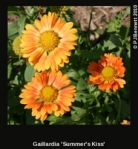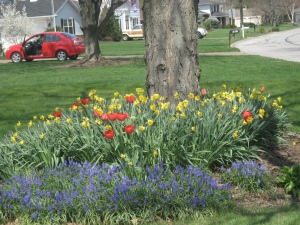To get a good idea on when to plant seeds indoors, count backwards from the outdoor planting target. For instance, if you want to plant broccoli in the garden the first week of May and the seed packet says to start indoors 6 weeks ahead of time, then count backwards 6 weeks from the first week of May. That would give you a mid-March sowing date indoors, for a early May transplanting out in the garden.
Order Seed Early
January 29, 2013
Seed / Propagation Leave a comment
Spring will be here earlier than you think and some transplants benefit from a headstart by sowing indoors. If you haven’t already done, so take a look at the catalogs and seed racks in the local garden centers. Figure out how much seed you need and make the order/purchase. If you wait too long, you may not get the varieties you want.
If you never tried growing from seed this might be a good year to start. Growing a couple tomato plants from seed is a nice way to expand your gardening experience.
MG Class of 2013
January 10, 2013
A new class of Master Gardener trainees gets underway on January 28th. Take a moment to welcome our newest colleagues. Not a Master Gardner, take a moment to check out the program or some of the activities we do throughout the area!
Erie County Master Gardener Volunteers host statewide workshop on Gibraltar Island
July 19, 2011
little island of Gibraltar, home of Stone Lab, may not be as easily recognized.
Stone Lab is a learning laboratory and an extension of The Ohio State
University. The connection with OSU and the subject matter studied at Stone Lab
is what lead the Master Gardeners to offer this advanced education trip to
their local membership as well as other Master Gardeners throughout the state. Sixty
volunteers from Erie County and nine other counties made the trip across Lake
Erie on a hot July day.
The Master
Gardener trip began with a Ferry ride to Middle Bass Island, a bus ride to
downtown Put-In-Bay and then a taxi boat ride over to Gibraltar Island. Once
the group arrived at Stone Lab, they
were greeted by John Hageman, Laboratory Manager and Associate
Sea Grant Extension Educator − Great Lakes. John shared the research and
teaching being done on the island and also gave a little history of the island
and its relationship to Ohio State. A brief history (from the website http://stonelab.osu.edu) of both the island and Stone
Lab is as follows:
The Gem of Lake Erie. Gib. The Rock. Gibraltar Island has many names and a
long history. Originally a territory of the state of Connecticut, it was
purchased by New York banker Pierpont Edwards in 1807. Soon after, it became a
key in the War of 1812 when, on September 10, 1813, Commodore Oliver Hazard
Perry used the island as a lookout point to spot the approaching British fleet
before the Battle of Lake Erie.
Jose DeRivera, a New York capitalist, bought the island
from Edwards in 1854. In 1864, Jay Cooke purchased the island for $3,001 and
almost immediately began construction on the 15-room Cooke Castle, which still
stands on the island. The Cooke family visited the island at least twice each
summer for nearly 60 years, entertaining hundreds of guests, including Salmon
P. Chase, General William Tecumseh Sherman, and President Rutherford B. Hayes.
After the death of Jay Cooke in 1905, the island passed
into possession of his daughter, Laura Barney. The Barneys made frequent visits
to Put-in-Bay until 1925, when they sold Gibraltar to philanthropist and Ohio
State University Board of Trustees member Julius F. Stone.
Stone presented the deed to the island to the Board as a
permanent home for the Lake Laboratory. The Board accepted the offer and moved
to establish the lab on Gibraltar, changing its name from Lake Laboratory to
Franz Theodore Stone Laboratory after Julius’ father. The 21-room Laboratory
Building, Dining Hall, Stone Cottage, and Gibraltar House were completed in
1928, and classes were first offered there in 1929.
Stone Laboratory is the oldest freshwater biological
field station in the United States and the center of Ohio State University’s
teaching and research on Lake Erie. The lab serves as a base for more than 65
researchers from 12 agencies and academic institutions, all working year-round
to solve the most pressing problems facing the Great Lakes.
In addition to its role as a research facility, Stone Lab
offers 30 college-credit science courses each summer for undergraduate and
graduate students, advanced high school students, and educators. The hands-on
sessions get students out into the field or out on the lake to study courses
like biology, geology, and natural resources.
After the introduction to the island and Stone Lab, the
Master Gardeners saw first-hand some of the research issues being studied in
the exotic and invasive species class, learned about the make-up of the island
and its relationship to the environment through the island geology class and
finally had a chance to walk the island discovering all the edible wild plants
that grow on the island and in many of our backyards.
After a full day of education classes and touring the
island, Master Gardeners taxied back to Put-in-Bay and either continued their
tour on their own or headed back to the mainland on the ferry. It seemed to be consensus
that this had been a fun, yet very educational trip for all those who attended.
The Erie County Master Gardener Volunteers planned this
workshop/tour for their group and other Master Gardeners to have an opportunity
to learn more about the island and the lake. This is just one example of the
many opportunities that Master Gardener Volunteers have to learn about
horticulture issues and our environment. If you think you might be interested
in these same opportunities, please contact the OSU Extension office in Erie
County. There is a Master Gardener Training Class being offered this fall in
Huron County and we are planning to offer a class in Erie County this winter.
Both classes will meet during the evening for several weeks.
Moles in the Yard
June 29, 2011
Moles have been active this season with increasing number of tunnels visible in yards. Ohioline Fact Sheet reveals that high water tables bring the moles closer to the ground surface which is why we are seeing more this year. OSU Extension recommends identifying main runways, those that appear to connect two mounds or feeding areas, and trapping the moles. Normally this would be most effective in spring or fall since moles are usually in deep soil in summer and winter. This summer might be the exception with a high water table.
Foliage of spring flowering bulbs
June 16, 2011
Is the dying foliage of your tulips and dafodils driving you crazy? Curb the desire to chop it down and add it to the compost bin. Wait until the foliage has turned completely yellow. The foliage produces the food for the bulb to enable it to grow again next year. You’ll be blessed with more flowers next spring
!
BLANKETFLOWER, GAILLARDIA (Gaillardia x grandiflora)
June 10, 2011
 Source: Buckeye Yard and Garden OnLine newsletter.
Source: Buckeye Yard and Garden OnLine newsletter.
Blanketflower is a great plant for hot, tough locations and is beginning to bloom in central Ohio. The large daisy-like flowers are often a combination of hot colors (red, yellow) and appear in early June and last for around 3 weeks. These plants tolerate hot dry soils and tend to be short-lived in moist, fertile soils. Heights are anywhere from 8-24″ and widths are 12-24″ depending upon the cultivar. Plant them in masses or groups in borders in full sun; they also tolerate light-shade. Common cultivars include ‘Dazzler’ (bright orange flowers with yellow tips, 24-30″ tall), ‘Goblin’ (red flowers with yellow tips, 12-15″ tall), and ‘Baby Cole’ (maroon flowers with yellow tips, 8-10″ tall). Plants should be deadheaded (dead flowers removed) as needed to prolong blooming. Divide plants every 2-3 years for best growth.
IMPATIENS – (Impatiens walleriana)
June 6, 2011
Article from the Buckeye Yard and Garden onLine newsletter found at: http://bygl@osu.edu
Now that the weather is finally cooperating, gardeners are planting lots of impatiens in shade gardens around Ohio! This easy-to-grow shade-lover does best in well-drained soils and in shade ranging from light to heavy.The more sun these plants get, the more water required to keep them healthy. Most of the newer cultivars don’t require pinching to make them bushy or deadheading (removing the dead blossoms). Plants grow anywhere from 6″ (pixie varieties) to 12-15″ tall. Flower colors are red, pink, orange, salmon, white, purple, and bi-color. The newer double cultivars are loaded with blooms compared to varieties from the past! Impatiens are relatively pest-free; however, it is a good idea to rotate them out of a flower bed every few years to avoid the potential for Verticillium wilt.
For more information, see:
How Does Your Garden Grow? Spring Seminar
March 23, 2011
If you are interested in learning more about keeping your landscape in bloom all season long, what trees to plant and where to plant them in your yard, how to grow those beautiful large blooms, or maybe how to start growing fruit? If any of these topics sound of interest to you, please join us at the EHOVE Career Center on April 16th for the Erie County Spring Seminar. For more information visit the OSU Extension, Erie County website at: http://erie.osu.edu/topics/master-gardener-volunteer-program/programs

